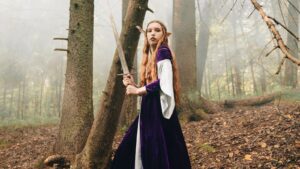Girl:Ar2avse7ppc= Elf
 Elves trace their origins back to Norse mythology, where they were known as “álfar.” Norse texts describe them as semi-divine beings associated with fertility and natural elements. In medieval Scandinavia, elves took on spiritual and supernatural roles, influencing human destiny.
Elves trace their origins back to Norse mythology, where they were known as “álfar.” Norse texts describe them as semi-divine beings associated with fertility and natural elements. In medieval Scandinavia, elves took on spiritual and supernatural roles, influencing human destiny.
In Germanic traditions, elves evolved into beings of influence and mystery. Described in texts like the Poetic Edda, they were seen as protectors of wisdom and nature. These myths spread throughout Europe, contributing to the popularized image of elves in folklore.
By the Middle Ages, elves appeared in British and Celtic folklore. Here, they resembled fairies, often depicted as mischievous or malevolent. These stories emphasized interactions between humans and elves, frequently showcasing elves’ magical abilities.
Elves gained literary prominence in the works of J.R.R. Tolkien. His portrayal of elves in “The Lord of the Rings” established them as noble, wise, and ageless beings. This transformation significantly influenced elf representation in modern fantasy literature and media.
Cultural Representations Of Elves
Elves captivate diverse creative expressions, manifesting richly in literature, films, television, art, and folklore. Each medium offers unique interpretations and nuances, maintaining their prominence in cultural narratives.
 Literature enriches traditional perceptions of elves by adding depth and variety. J.R.R. Tolkien’s works, like “The Lord of the Rings,” portray them as majestic and wise beings, setting a benchmark for modern fantasy. Besides Tolkien, Terry Pratchett’s “Discworld” series presents elves as cunning and malicious beings, adding a layer of intrigue. Authors like J.K. Rowling in the “Harry Potter” series feature elves as dedicated housekeepers, showcasing their subservient traits and cultural significance.
Literature enriches traditional perceptions of elves by adding depth and variety. J.R.R. Tolkien’s works, like “The Lord of the Rings,” portray them as majestic and wise beings, setting a benchmark for modern fantasy. Besides Tolkien, Terry Pratchett’s “Discworld” series presents elves as cunning and malicious beings, adding a layer of intrigue. Authors like J.K. Rowling in the “Harry Potter” series feature elves as dedicated housekeepers, showcasing their subservient traits and cultural significance.
Films and television bring elves to life with visual storytelling. In Peter Jackson’s “The Lord of the Rings” adaptations, their ethereal beauty and combat prowess mesmerize audiences. The “Harry Potter” films depict elves like Dobby with unique personalities, emphasizing their loyalty. In contrast, the TV series “The Witcher” explores elves’ struggles and resilience, highlighting their marginalized existence in a human-dominated world.
Art and folklore infuse elves with enchanting characteristics, blending historical and creative perspectives. Artworks often depict elves as delicate, nature-loving creatures with pointy ears, reflecting folklore’s influence. In Scandinavian folklore, they appear as mysterious, protective spirits of nature. Celtic traditions visualize them as mischievous, fairy-like apparitions, linking them to magical happenings. Throughout global narratives, elves symbolize mystery and allure, demonstrating the timeless fascination with these mythical entities.
Characteristics And Abilities Of Elves
 Elves captivate with their distinct characteristics, blending ethereal beauty and extraordinary abilities. These elements establish them as prominent figures in mythology and popular culture.
Elves captivate with their distinct characteristics, blending ethereal beauty and extraordinary abilities. These elements establish them as prominent figures in mythology and popular culture.
Elves often possess striking physical features setting them apart from humans. Typically, they have pointed ears and sharp, symmetrical facial structures. Their elegant demeanor enhances their mystique. Elves are usually described as tall and slender, exuding grace and agility in their movements. In literature, their appearance might symbolize timelessness, underscoring their long lifespans and connection to nature.
Elves exhibit remarkable magical abilities, deeply rooted in their affinity with nature. They frequently harness elemental forces like earth, air, and water, enabling them to manipulate the environment. In various narratives, elves demonstrate telepathy or heightened senses, showcasing their intuitive understanding of the natural world. Some versions emphasize their skill in enchantment, allowing them to cast spells or create illusions. These abilities, both practical and mystical, contribute to elves’ revered status in fantasy realms.
Connection to Nature
Elves, with their rich history and evolving portrayals, continue to enchant audiences worldwide. From their ancient roots in Norse mythology to their prominent roles in modern literature and media, elves embody a blend of mystery, wisdom, and magic. Their enduring appeal lies in their ability to adapt to various cultural narratives while maintaining their connection to nature and the mystical.

